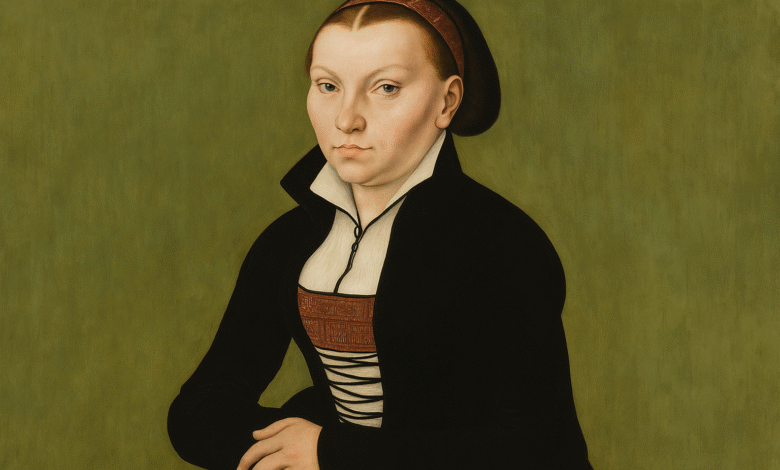Martin Luther Wife: The Bold Life and Enduring Legacy of Katharina von Bora
From Nun to Reformer’s Partner — How Katharina von Bora Redefined Faith, Family, and the Role of Women in Reformation History

Introduction: Who Was Martin Luther’s Wife?
Katharina von Bora, famously known as Martin Luther’s wife, was far more than just the spouse of the great Protestant Reformer. She was a revolutionary figure in her own right, who defied the expectations of her era. Born into minor nobility and raised in a convent, she rejected religious vows to become a central figure in shaping the ideals of Protestant family life. Her journey from cloistered nun to the matriarch of a reformer’s household embodies courage, resilience, and vision.
Often overlooked in the shadows of Luther’s theological battles, Katharina’s contributions to the Reformation were equally profound on a domestic and social scale. Her practical support allowed Luther to focus on his teachings, while she built a model Protestant household that influenced generations to come.
Quick Bio Table
| Attribute | Details |
|---|---|
| Full Name | Katharina von Bora |
| Date of Birth | Circa 29 January 1499 |
| Birth Place | Likely Lippendorf or Hirschfeld, Saxony |
| Nationality | Saxon German (Holy Roman Empire) |
| Ethnicity | German (Saxon gentry) |
| Accent | Upper Saxon German |
| Education | Convent education (Nimbschen Abbey) |
| Husband | Martin Luther |
| Children | Hans, Elisabeth, Magdalena, Martin, Paul, Margarete |
| Parents | Likely Hans von Bora and Anna von Haugwitz |
| Occupation | Homemaker, Estate Manager, Brewer |
| Died | 20 December 1552, Torgau |
Childhood in Saxony
Katharina von Bora was born around 1499 in the Saxon region of the Holy Roman Empire. Her noble family background meant she was sent to a convent at a young age, a common practice for daughters of minor aristocracy. At the age of five, she entered a Benedictine convent in Brehna and later moved to the Cistercian monastery in Nimbschen.
Life as a Cistercian Nun
While at Nimbschen Abbey, Katharina was educated in literacy, religion, domestic duties, and possibly Latin. She took her final vows as a nun in her mid-teens. However, her exposure to Martin Luther’s early writings sparked a profound internal conflict. Like many of her peers, she began questioning the monastic life and sought an escape from the cloistered world.
Escape and Rebirth in Wittenberg
Flight from the Convent
In 1523, Katharina and eleven other nuns made a daring escape from Nimbschen Abbey with the help of Martin Luther and local sympathizers. Hidden in a fish wagon, they fled to Wittenberg, where their arrival caused a public stir. Most of the women were placed in homes or arranged marriages, but Katharina was different.
A Bold Marriage Proposal
Luther initially sought to find her a suitor, but Katharina confidently expressed her preference: she would marry only Martin Luther or his associate Nicholas von Amsdorf. Her confidence and clarity led to her marriage to Luther in 1525. This union shocked Europe and became a symbol of Protestant change — clergy could now marry and lead family lives.
Marriage to Martin Luther
A Model Protestant Household
Their marriage was not just personal but ideological. Katharina managed the Black Cloister — their large household — which included children, students, and frequent visitors. She handled the finances, cultivated land, raised livestock, ran a brewery, and opened their home to travelers and scholars. Her ability to manage these responsibilities allowed Luther to focus on his reformist work.
Partnership in Practice
Though Martin Luther affectionately called her “Herr Käthe” in jest, it reflected the respect he had for her administrative skill and intellect. Their relationship was based on mutual admiration. Letters between them reveal that she often offered advice and occasionally challenged him, showing the depth of their partnership.
Children and Family Life
Raising the Luther Family
The couple had six children: Hans, Elisabeth, Magdalena, Martin, Paul, and Margarete. They also took in orphans and relatives, creating a bustling, nurturing household. Unfortunately, two of their daughters died young — Elisabeth in infancy and Magdalena at 13 — events that deeply affected both parents.
Teaching by Example
Katharina played an essential role in establishing the ideal of a Protestant family life. She taught household skills, faith, and discipline, embodying the new model of womanhood — educated, active, and influential within the home and community.
Later Years and Struggles
Widowhood and War
After Luther’s death in 1546, Katharina’s life took a difficult turn. The Schmalkaldic War brought financial hardship, and she had to flee Wittenberg several times. Her economic situation declined rapidly due to legal complications regarding Luther’s estate.
Final Days in Torgau
In 1552, during a plague outbreak, she traveled to Torgau with her children. A carriage accident caused serious injuries, and she died shortly after, on 20 December 1552. Her reported last words were, “I will stick to Christ as a burr to cloth,” a reflection of her unwavering faith.
Legacy and Historical Impact
Redefining Womanhood
Katharina von Bora’s life redefined what it meant to be a woman in Reformation Europe. She showed that wives of clergy could be influential, educated, and deeply involved in both public and private life. Her model of domestic leadership set the standard for Protestant households for centuries.
Honours and Remembrance
Katharina is remembered annually on 20 December in the Lutheran Church calendar. She has been the subject of scholarly works, books, operas, and plays. In 2025, the 500th anniversary of her marriage to Luther was celebrated across Europe and North America, reaffirming her role as a pivotal Reformation figure.
Conclusion: More Than a Reformer’s Wife
Katharina von Bora was not just Martin Luther’s wife — she was a pioneer who helped shape the very fabric of Protestant society. Her fearless transition from a cloistered life to one of public leadership and household mastery is a story of faith, intellect, and perseverance. In her, the Reformation found not only a symbol of change but a cornerstone of family, community, and conviction.
Frequently Asked Questions (FAQ)
Who was Martin Luther’s wife?
Martin Luther’s wife was Katharina von Bora, a former Cistercian nun who escaped convent life and became a key figure in the Protestant Reformation.
How did Katharina von Bora escape the convent?
She and 11 other nuns escaped the Nimbschen Abbey in a herring wagon with Martin Luther’s help in 1523.
When did Martin Luther marry Katharina von Bora?
They were married on 13 June 1525 in Wittenberg.
How many children did they have?
They had six children, though two daughters died at a young age.
What was Katharina von Bora’s role in the Reformation?
She managed Luther’s household, supported students and travelers, and set the model for Protestant clergy families through her leadership and faith.




